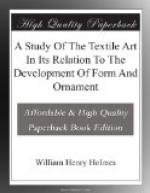Color employed in the art is not related to use, excepting, perhaps, in symbolic and superstitious matters; nor is it of consequence in construction, although it derives importance from the manner in which construction causes it to be manifested to the eye. It finds its chief use in the field of design, in making evident to the eye the figures with which objects of art are embellished.
Color is employed or applied in two distinct ways: it is woven or worked into the fabric by using colored filaments or parts, or it is added to the surface of the completed object by means of pencils, brushes, and dies. Its employment in the latter manner is especially convenient when complex ideographic or pictorial subjects are to be executed.
TEXTILE ORNAMENT.
Development of A geometric system of design within the art.
Introduction.
Having made a brief study of form and color in the textile art, I shall now present the great group or family of phenomena whose exclusive office is that of enhancing beauty. It will be necessary, however, to present, besides those features of the art properly expressive of the esthetic culture of the race, all those phenomena that, being present in the art without man’s volition, tend to suggest decorative conceptions and give shape to them. I shall show how the latter class of features arise as a necessity of the art, how they gradually come into notice and are seized upon by the esthetic faculty, and how under its guidance they assist in the development of a system of ornament of world wide application.
For convenience of treatment esthetic phenomena may be classed as relieved and flat. Figures or patterns of a relievo nature arise during construction as a result of the intersections and other more complex relations—the bindings—of the warp and woof or of inserted or applied elements. Flat or surface features are manifested in color, either in unison with or independent of the relieved details. Such is the nature of the textile art that in its ordinary practice certain combinations of both classes of features go on as a necessity of the art and wholly without reference to the desire of the artist or to the effect of resultant patterns upon the eye. The character of such figures depends upon the kind of construction and upon the accidental association of natural colors in construction.
At some period of the practice of the art these peculiar, adventitious surface characters began to attract attention and to be cherished for the pleasure they gave; what were at first adventitious features now took on functions peculiar to themselves, for they were found to gratify desires distinct from those cravings that arise directly from physical wants.




